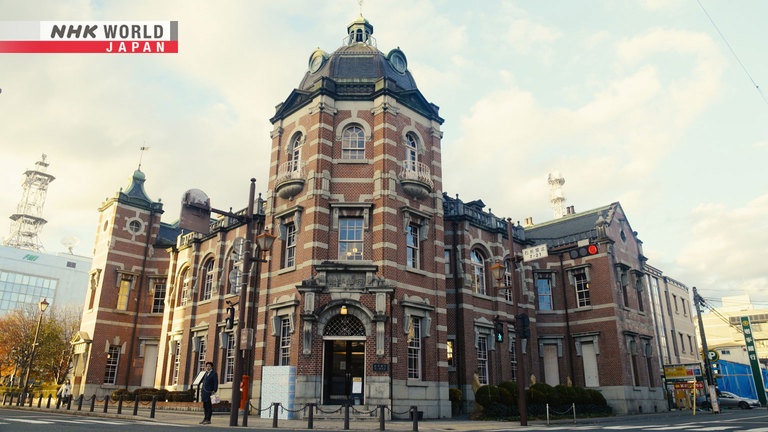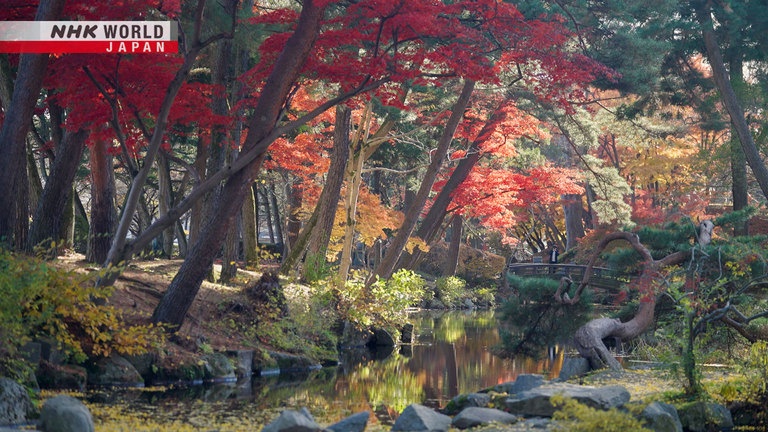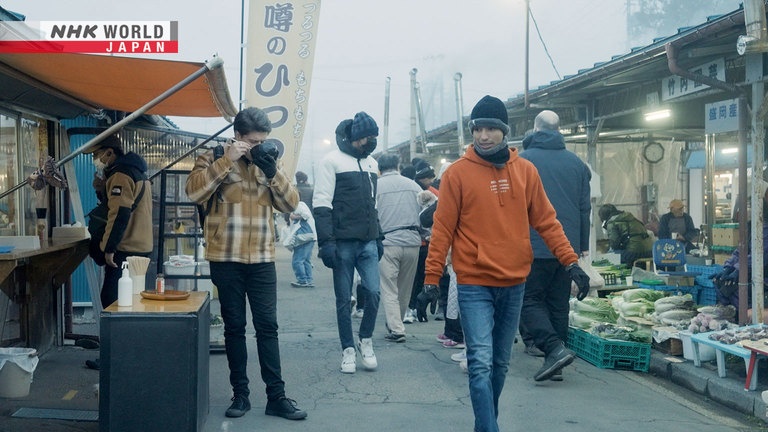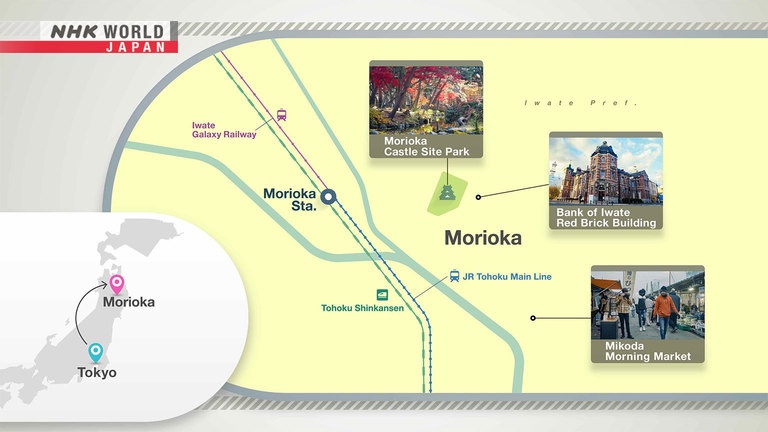Morioka: Slow Life, Indie Spirit
In January 2023, the New York Times newspaper introduced Morioka as one of its "52 Places to Go" - second only to London. The capital of Iwate Prefecture was highly praised for its historic architecture; its compactness, making it easy for people to get around on foot; and the abundance of nature, from the nearby mountains to the river that runs through the city center. On this episode of Journeys in Japan, Canadian actor Kyle Card visits this city which is little known abroad and often overlooked at home. He explores its independent stores and numerous coffee shops, and chats with the people who call it home.
Bank of Iwate Red Brick Building

Built in 1911, this handsome edifice was designed by the renowned architect Tatsuno Kingo together with Kasai Manji, the same partnership that designed the iconic Tokyo Station building. The Bank of Iwate Red Brick Building is designated as an Important Cultural Property.
Morioka Castle Site Park

In feudal times, Morioka was the seat of the Nanbu domain. The site of the clan's former castle was opened to the public as a park in 1906 and is known for its cherry blossoms in spring.
Mikoda Morning Market

Nicknamed "Morioka's kitchen," this popular street market operates more than 300 days a year, opening each morning at 5 AM.
Access

To reach Morioka from Tokyo, it takes about 120 minutes by the Tohoku Shinkansen bullet train. The city center is about twenty minutes on foot from Morioka Station.
Transcript
"Journeys in Japan"
Hello, everyone. I'm Kyle Card here
at the infamous scramble crossing in Shibuya, Tokyo.
Ever since corona ended, travelers from all over the world have gathered here again,
and it's back to business as usual.
Although this is a great thing, I personally would like to escape this bustling chaos.
Jump on a Shinkansen bullet train,
and the city of Morioka is just a couple of hours away.
So I've just arrived in Morioka,
and I cannot wait to see what this city has to offer.
Let's go explore it.
Morioka, in Iwate Prefecture,
was picked by the "New York Times" newspaper
as one of its 52 must-visit places of 2023, second only to London.
Even in the city center, you're never far from nature.
It's a place you can get around on foot.
And the historic buildings give it a character all its own.
It's a city with a lot to offer.
On this edition of "Journeys in Japan,"
Kyle Card explores Morioka to find out more,
and to meet the people who live there.
Wow, it's so colorful!
Thank you.
Morioka: Slow life, indie spirit
Morioka City lies in the center of Iwate Prefecture,
some 460 kilometers north of Tokyo.
It has a population of around 280,000.
From the 17th century onward,
Morioka prospered as a castle town.
The modern city spreads out from the park where the castle used to stand.
Wow.
You know, it's just like it was written in the "New York Times" article.
The proximity between the city and nature is just so close.
How truly wonderful to be able to just go for a short walk
and be enveloped in such beautiful nature
with wonderful views of Mount Iwate and the pristine rivers.
It's truly refreshing.
Just as the "New York Times" article states,
there is so much historic and traditional architecture left over in Morioka.
For example, take a look at this Western-influenced
red brick building behind me.
It gives so much impact and character to the area.
By the looks of it, it used to be a bank.
I'd love to go take a look inside.
Oh, that's amazing.
Would you look at that? It's just gorgeous.
The detailed wood work,
chandeliers.
And check out the stonework. Like, this is just beautiful.
Actually, this property is actually a National Important Cultural Property.
It was built in 1911.
And it's been used for a bank until the year 2012.
So, about 100 years of usage.
All right. So I've walked about 15 minutes from Morioka Station
to the central shopping area.
And I have to say, this place is bustling.
This is really easy just to walk around here in Morioka.
Very compact and everything just super close.
The article also said that Morioka is host to a large variety
of independently owned shops,
so I'm going to go check a few out.
I wonder what's in this place?
It looks like a T-shirt shop.
"CATS ARE ALRIGHT."
"COFFEE FROM HELL."
Of course, there's a cat.
- Hello.
- Hello.
- So, this is a T-shirt shop?
- Yes.
I design and print them. And I sell them here.
As soon as I moved here, the first thing I noticed was how compact this town is.
Even a small shop like mine, people here will notice and stop by.
They have very individual tastes.
They prefer independent shops, rather than chain stores.
There are lots of second-hand record shops. I can think of five, just around here.
- So many?
- Really a lot.
So many. Wow.
Whitney Houston...
Michael Jackson, "Thriller." Whoo! That's a classic.
- Michael Jackson is amazing.
- Absolutely.
There are so many records, it's hard to decide.
It's like listening to a live performance.
Yes.
I moved to Morioka straight after high school.
Time moves more slowly here. It's like the speed of a record going round.
I felt I wanted to sell records in this place where time flows slowly.
Records seem to suit the pace of life in Morioka.
There's one more I'd like to play for you.
We put this record out on our own label.
- Does it say "coffee town"?
- Right!
Morioka has so many coffee shops. And this song is about them.
There's a map of local coffee shops included with the record.
Here's Morioka Station, and the main street.
As you see, there are lots of coffee shops.
- There are really so many?
- This is just some of them.
Now I really feel like having a coffee.
- Why don't we go get one?
- Let's go!
OK!
According to the "New York Times" article,
Morioka, with its rich history and culture of coffee,
has an exponential amount of Japanese coffee shops.
So a great cup of coffee is only a short walk away.
Now this is the first location I want to check out.
Check out the pretty glasswork in the window.
It gives off a very artistic vibe.
I love this.
All the woodwork really gives off like this log house cottage vibe.
So, kind of like a saloon as well.
Take a seat.
It says "old coffee." But 1992?
I bought it about 30 years ago.
- Are the beans still OK?
- They're fine.
You could say they've matured.
Coffee beans roast well when they've been allowed
to gradually lose their moisture.
They develop an aroma that's different than when they're fresh.
How do you like your coffee? Bitter? Or with some acidity?
I prefer bitter.
Seki Motohiro took over his parents' cafe in 1994,
turning it into a place where people could come to enjoy coffee
that he roasts in-house.
His focus now is on serving coffee brewed from beans that he ages carefully.
You're not using a paper filter.
I use a cotton flannel filter. I prefer the flavor this way.
I don't think I've seen a cup of coffee being put in with so much intention,
just like, you know, drip by drip, you know?
How long does it take you for each cup?
From 2 or 3 minutes to as much as 4 or 5 minutes.
Rather than digital data,
I focus on the temperature of the water and the aroma.
You heat it up after you've brewed it?
It gets lukewarm when it takes so long.
Here you go. Kenyan beans from 1993.
Really rich!
It's just got this depth, you know. It's got a little bit of
tartness to it as well, but there's also like these
kind of fruity tones in it as well.
It's like a fine wine, really.
I bought the beans when I first opened here.
They've been aging together with my shop.
There's a lot of history in this cup.
Each different coffee shop has its own flavor.
That's what makes Morioka so enjoyable.
Well, I've just finished drinking some very intriguing
and delicious old-beans coffee.
And now I'm off to my next location.
Sunshine. What a great day.
Looks like another Japanese-style coffee shop.
Excuse me, what's in those bags?
These are green coffee beans.
They look heavy. Can I give you a hand?
Really? Thank you.
This one is 10 kg.
Thank you so much.
- Can I put them down here?
- That's good. Thank you.
The beans look shiny and good.
Those are a dark roast, so the oils are on the surface.
They're in top condition.
There's such a great aroma.
- I'm roasting some beans now.
- You roast them yourself?
That looks like a vintage roaster.
My father bought it second-hand in 1989. So it's really old.
There's no manual or anything.
I learned by watching and listening to my father.
He used to place his hand on the roaster.
It's interesting to hear you learned that way.
This coffee shop was opened in 1980 by Takahashi Mana's father.
She took over in 2019, after he died,
drawing on what she had learned from him.
For her, it's important to keep his legacy alive.
The aroma is just heavenly.
There's this sweetness to it. It smells almost like a
almost like a freshly baked chocolate cake kind of thing.
I don't know, it just smells delicious.
It makes you want to salivate, actually. Ah!
Takahashi has kept the flavor of the coffee unchanged,
and still sees regular customers from her father's time.
I first came here 10 years ago, together with my wife.
10 years ago?
It still has that warm feeling.
I was struck by the aroma of the beans as they came out of that vintage roaster.
It made a deep impression on me.
Even though my father is no longer here and Morioka is changing with the times...
I really want to keep this place unchanged, just the way it is.
And the most important thing is to keep
the taste of the coffee that my father made.
It is hard to believe that I'm in the center of the city
and still be surrounded by this beautiful and calming nature
complete with blazing autumn foliage. It's truly surreal.
Good morning. It is 5 AM and a frigid 4 degrees.
And behind me is the Morioka Morning Market.
Really curious what I can see inside. Let's go take a look.
Oh, wow, look at that.
Smoky, foggy ambience. Cool.
This early-morning farmers' market opens at 5 AM.
It's been held here since 1968.
Although it mainly features fresh produce,
there are plenty of other stalls as well.
Roasted sweet potatoes!
- Could I have one of these?
- Go ahead. Take 10 of them!
Well, just one for now.
Can I just bite into it?
Of course. You won't lose your teeth.
Wild.
Oh! That's delicious.
Great!
- It's really sweet, isn't it?
- Really sweet!
You can see how cold it is outside today.
Look at all the steam.
Let's continue.
"Hittsumi." What's hittsumi?
Excuse me. What is hittsumi?
It's a local Iwate dish.
We make a dough from flour and water, then cook it.
- It's like a noodle?
- That's right.
- Here you go.
- It looks great.
We add burdock, carrot and mushrooms. There's no meat in it.
Check out that noodle.
It's a big, flat noodle.
That's chewy.
It's like a lovely vegetable broth with a bit of dashi in there.
That's really good. Ah, it's so great on this frigid morning.
"Asaichi" coffee.
150 yen. That's a steal, wow.
Good morning. Could I have a coffee?
- It's 150 yen, right?
- Yes.
- Here it is.
- Thanks. It smells great!
Oh, that's smooth and wonderful.
How long have you been doing this?
About 40 years.
Wow!
- May I ask your age?
- I'll be 81 this year.
Really? I'd never guess. You're so youthful!
Sato Koji roasts all his coffee himself.
He's been in the business for almost 50 years,
and is one of the veterans of Morioka's coffee scene.
I come down here for this coffee.
Every day? How long have you been coming here?
I wonder? Maybe 20 years?
That long? That's wonderful.
We're very grateful.
We're here at least 300 days a year.
We wake early and breathe in the fresh air.
Rising early to work is the key to good health.
And also great coffee every morning, right?
Yes. Never forget that.
There are so many traditional buildings along this strip.
It just really gives you a great sense of the history of the area.
It's really cool.
This district, Natayacho, still retains the feel of the old days.
The houses here date back over a century
and are protected by the local residents.
I think there's a group of people... cleaning something?
I wonder what they're up to?
Excuse me. What are you doing?
We're cleaning this well.
Cleaning it?
This well is called Seiryusui. The local people all use it.
It's been in use since the Edo period.
In the past, homes didn't have running water.
So people drew water here for use in their homes.
The water here was picked as one of the 100 best spring waters of the Heisei era.
Really?
I run a coffee shop nearby.
I use this water when I brew coffee or make matcha tea.
It must be delicious.
Yoshida Masahiro moved to Morioka from Tokyo in 2007.
It's his wife's hometown and he's always loved it.
He runs a coffee shop in one of the traditional houses,
which played a key role in helping to preserve this traditional district.
In 2005, there was a plan to widen the road out front.
It would have destroyed this area.
However, campaigning against it would have achieved nothing.
My wife used to come up here from Tokyo once a month for handicraft class.
Someone suggested she should convert the classroom and turn it into a coffee shop.
So that's what we did.
We wanted people to see for themselves the importance
and charm of these old houses.
We thought people would understand better
why we were opposed to the road construction.
The local residents held an event to show people
what makes their neighborhood so special.
You can't understand the quality of this house just walking past on the street.
Please come in.
- Is that OK?
- Have a look.
Come through here, please.
Wow, it's so colorful!
Thank you.
Beautiful! Look at the "hina ningyos." Oh, beautiful.
In the old days I used to go to people's homes
and ask them if I could see their hina doll displays.
So I started from that as a reference point,
as a way of showing them how good this house is.
They invited visitors into their homes to view their hina doll collections,
which are usually displayed only around the Girls' Day Festival.
Yoshida's coffee shop became one of the main venues for promoting the event.
So, it wasn't just a campaign against the plan.
You actually showed them the reason why.
It worked. The construction was canceled.
I think the hina dolls played a big role in that.
- That's really great.
- Yes, I think so too.
Time flows differently in Morioka.
The people that gather here enjoy a slow, introspective lifestyle.
The result is the design of an atmosphere and pace
that works uniquely for them,
allowing them to live with conscious intention.
Flying in the face of an ever-modernizing
world hurtling forward at breakneck speed, in Morioka,
they continue to succeed in the deceleration of the flow of time,
while enjoying a good book, some great music, or
a cheeky coffee along the way.
To reach Morioka from Tokyo,
it takes about 2 hours and 10 minutes by Tohoku Shinkansen.
The city center is about 20 minutes on foot from Morioka Station.
There are many specialist coffee shops dotted around Morioka.
This shop ran for 40 years but closed down.
Now it's been revived thanks to its loyal customers.
The owner of this coffee shop went to college in Morioka.
He runs another popular coffee shop in Tokyo these days,
so his friend manages the operation here.
I thought this shop would serve as a refuge for some people,
just like it did for me in my youth.
I thought it would help if I kept the lights on here.